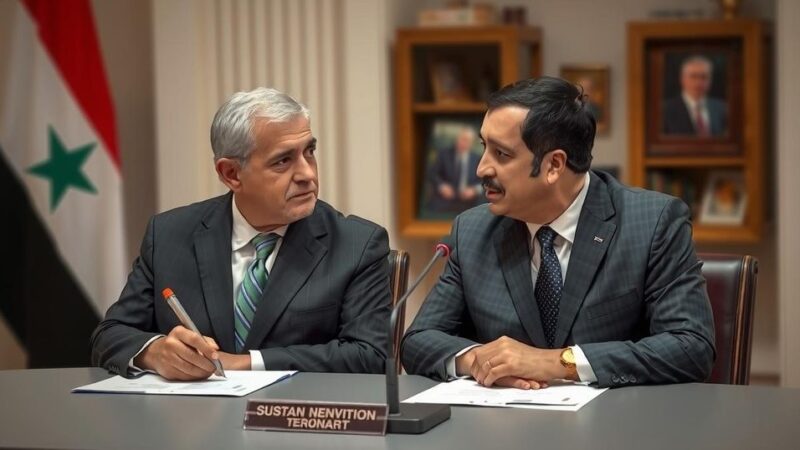An attack on the al-Asad airbase in Iraq wounded several U.S. troops amid escalating Middle East tensions. The incident is viewed as potentially linked to broader regional hostilities arising from the Israel-Gaza conflict, with Iranian-backed militia operations complicating the situation. Experts warn of the dangers of escalation, depending on Iran’s response to recent assassinations of key figures.
On Monday, an assault targeted the al-Asad airbase in Iraq, resulting in injuries to at least five American military personnel and two contractors. While this may be perceived as an isolated episode, there are indications that it could signify a wider escalation in hostilities within the region. The strike occurs amidst a backdrop of intensifying violence in the Middle East, notably as Israel continues its military operations in Gaza and is reported to have executed the assassinations of prominent figures, including Hamas political leader Ismail Haniyeh and Hezbollah military commander Fuad Shukr, in recent weeks. Iran, which supports both Hamas and Hezbollah, has attributed the orchestrated attacks to Israeli actions and is anticipated to retaliate, heightening concerns regarding a broader conflict. The precise involvement of Iran in the attack on al-Asad is uncertain, and currently, no group has claimed responsibility. Nevertheless, there exist Iranian-affiliated militias operating within Iraq, such as the well-known Kataib Hezbollah. It is crucial to note, however, that while these groups may have ties to Iran, they sometimes conduct operations autonomously without direct orders from Tehran. The recent assaults serve as a poignant reminder of the precarious nature of the Israel-Gaza conflict and its potential to escalate into a wider confrontation. Discussions surrounding the U.S. military presence in Iraq have been complex; Iraqi President Mohammed Shia al-Sudani expressed intentions in January to expel U.S. forces, yet approximately 2,500 American troops remain engaged in efforts to combat the Islamic State. Recently, U.S. forces have launched strikes against militias suspected of planning drone attacks that jeopardized U.S. bases. These militias, known as Popular Mobilization Forces (PMFs), are often described as Iran-backed, reflecting the intricate nature of the relationships involved, as they exhibit a degree of independence from direct Iranian directives. The analogy of retaliation is evident in the Monday attack, as it may be construed as a reaction to a U.S. operation that resulted in four casualties in the preceding week. Additionally, the strike could symbolically be part of Iran’s response to the targeted assassinations of Haniyeh and Shukr, particularly given the sensitive nature of Haniyeh’s death occurring within Iranian territory. As articulated by experts, the Iranian leadership faces the challenge of formulating a response that conveys strength without provoking further military action from Israel and the United States. The delicate balance of power demands a strategic approach to avoid appearing weak while not triggering an uncontrollable escalation of hostilities. Significant deliberation surrounds the potential ramifications of Iranian retaliation, including the possibility that it could draw the U.S. deeper into the fray. Looking ahead, the dynamics involving the response of Iran and its affiliates to incidents of aggression will be pivotal in determining the scale of conflict and its implications. The possibility that Iranian partners might surge rocket attacks towards Israel poses significant risks; failure to counter such moves effectively could result in high civilian casualties and inflame tensions further. In summary, the ongoing geopolitical situation in the Middle East indicates a fraught environment, wherein calculated escalations have the potential to precipitate broader conflicts. The international community continues to observe closely as Iranian actions in response to provocations may redefine the security landscape across the region.
The complexities within the Middle East have been exacerbated by the ongoing Israel-Gaza conflict, with rising tensions igniting fears of wider warfare. The recent attack on U.S. troops at the al-Asad airbase underscores the fragile state of security in the region. The strategic interplay between various actors, including Iran and its affiliates in Iraq, Israel, and U.S. military forces, creates a highly volatile situation marked by retaliatory strikes and potential escalations in violence. The operational dynamics of the PMFs, their ties to Iran, and the validity of their independent actions complicate the geopolitical scenario further. The U.S. involvement in Iraq remains contentious and precarious, underscored by the Iraqi government’s expressed desire to expel U.S. forces despite their ongoing role in combating ISIS. Iran’s regional aspirations, as manifested through its support for militant groups, serve to challenge U.S. objectives and contribute to the intricate balance of power in the Middle East.
The attack on the al-Asad airbase has amplified concerns regarding potential escalations in the Middle East, particularly against the backdrop of the ongoing Israel-Hamas conflict and Iran’s complex relationship with various militias. The U.S. military presence in Iraq remains a contentious issue, heightened by recent hostilities and the looming threat of retaliatory actions from Iranian-backed forces. The responses from Iran, coupled with the regional dynamics involving both Israel and the U.S., forecast a precarious landscape that may evolve into a broader conflict if not managed with diplomacy and strategic restraint.
Original Source: www.vox.com







